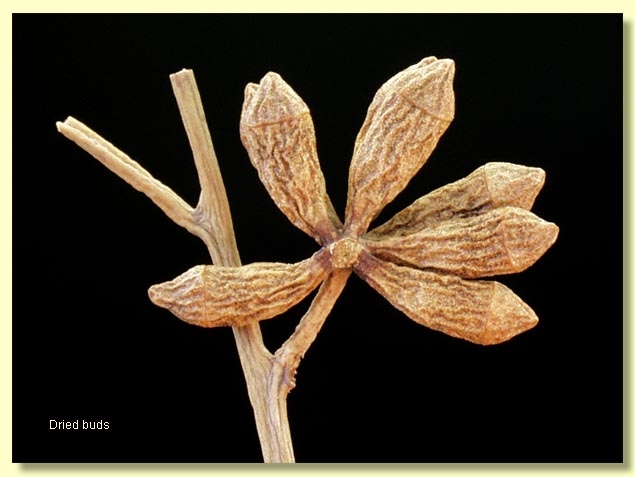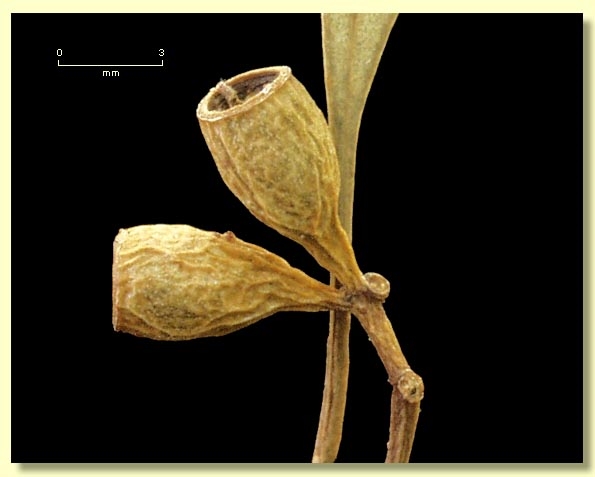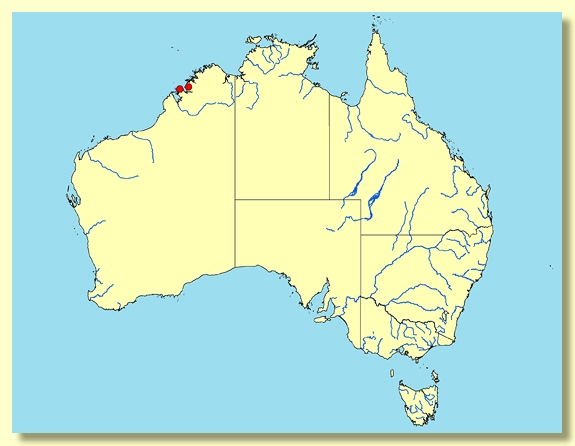Euclid - Online edition
Eucalyptus kenneallyi
Eucalyptus | Symphyomyrtus | Platysperma
Eucalyptus kenneallyi K.D.Hill & L.A.S.Johnson, Telopea 8 (4) 518 (2000).
T: Western Australia: Storr Island, between Doubtful Bay and George Water, Kimberley Coast, K.Kenneally 11083, 17 July 1990; holo: NSW; iso: PERTH.
Tree to 8 m tall. Forming a lignotuber.
Bark smooth throughout, white to grey to brown or pink.
Juvenile growth (coppice or field seedlings to 50 cm): not seen.
Adult leaves alternate, petioles 1–2.3 cm long; blade lanceolate, 6–11 cm long, 0.7–2 cm wide, base tapering to petiole, margin entire, apex pointed, concolorous, dull green to grey-green, side-veins acute, reticulation moderate to dense, intramarginal vein present and usually very close to the margin.
Inflorescence axillary unbranched, peduncles 0.3–0.5 cm long, buds per umbel 7, rarely in 3s, pedicels 0.1–0.2 cm long. Mature buds club-shaped to obovoid, 0.6–0.7 cm long, 0.25–0.3 cm wide (from Hill, ibid.), scar present, operculum conical, stamens irregularly inflexed, anthers oblong, versatile, dorsifixed, dehiscing by longitudinal slits, style long and straight, stigma blunt, locules 3(4), the placentae each with 6 vertical rows. Flowers white.
Fruit shortly pedicellate (pedicels 0.1-0.2 cm long), cylindrical, 0.4–0.5 cm long, 0.3–0.35 cm wide, non-glaucous, disc vertically descending, valves 3(4), enclosed.
Seeds brown to yellowy brown, flattened-ovoid, dorsal surface shallowly reticulate, edge of seed smooth, hilum ventral.
Cultivated seedlings (measured at ca node 10): not seen
Flowering time unknown.
A small tree, known only from Storr Island and Koolan Island, two small islands just off the Kimberley Coast of Western Australia. Characterised by the smooth white powdery bark, the dull, narrowly lanceolate to lanceolate adult leaves and the small cylindrical fruit with a narrow descending disc.
Eucalyptus kenneallyi belongs in a group of species that are distinguished by having smooth bark, moderate to dense reticulation in the adult leaves and flat, flattened-ovoid, non-toothed, pale yellow-brown to brown seeds with a ventral hilum. The other members of this group are E. rupestris, E. umbrawarrensis, E. leucophloia, E. confluens, E. brevifolia and E. ordiana.
Within this group, E. kenneallyi is very close to E. rupestris. The two can only be separated on the shape of the adult leaves, narrowly lanceolate to lanceolate in E. kenneallyi and elliptic to ovate to broadly lanceolate in E. rupestris. It is also closely related to E. umbrawarrensis and can be easily separated by its dull adult leaves (E. umbrawarrensis with glossy adult leaves). E. leucophloia is distinguished by its hemispherical to cup-shaped fruit normally 0.4 cm wide or wider and umbel peduncle 0.5 cm or longer (E. kenneallyi with small cylindrical fruit, normally narrower than 0.35 cm and umbel peduncles 0.5 cm or shorter). Both E. brevifolia and E. confluens can be distinguished by their broad flat to slightly ascending disc of the fruit (E. kenneallyi with a narrow descending disc) and E. confluens can be further separated by having glossy adult leaves (dull in E. kenneallyi). E. ordiana differs by retaining its broad juvenile foliage through to the mature crown (E. ordiana with mature crown leaves greater than 3 cm wide and E. kenneallyi with narrowly lanceolate to lanceolate mature crown leaves normally narrower in width than 2 cm).
Eucalyptus kenneallyi is restricted to two small islands off the Kimberley coast, and so far, has not been found on the mainland and therefore should not be confused with any other white gum growing close to its area of occurrence, i.e. E. alba var. australasica, E. apodophylla, E. cupularis, E. herbertiana, E. houseana, E. mooreana and E. pantoleuca. However, if required, the following comparisons apply for these species. The adult leaves of E. kenneallyi are narrowly lanceolate and usually no longer than 11 cm and no wider than 2 cm. E. alba var. australasica has relatively large, broadly lanceolate to ovate leaves, normally longer than 8 cm and wider than 2.5 cm. E. apodophylla has large, opposite, elliptical to ovate to broadly lanceolate adult leaves, normally longer than 7 cm and wider than 3 cm. E. cupularis, E. herbertiana and E. houseana all have relatively long lanceolate adult leaves, normally longer than 8 cm. E. mooreana has large elliptical to ovate adult leaves, normally wider than 3.5 cm and E. pantoleuca has large opposite, orbicular to deltoid adult leaves, normally longer than 9 cm and wider than 7 cm.
Eucalyptus kenneallyi : after Kevin Francis Kenneally (1945– extant 2009). Kevin Kenneally is a botanist with the Western Australian Department of Conservation and Land Management. He joined the W.A. Herbarium in 1973 and has a wide knowledge of the Western Australian flora, with a particular interest in the flora of the Kimberley region. He has made a significant contribution to the knowledge of the Western Australian flora through his many scientific papers and his extensive plante collections. In 2005 Kevin was appointed a Member of the Order of Australia in recognition of his service to the community through a range of organisations promoting environmental education, advancement of botanical knowledge and the interest of youth in natural history.








